Project
Empirical analysis related to the business cycle in the macroeconomy and macroeconomic policy is being conducted using time-series data. Specifically, empirical analysis based on causal relationships is carried out by applying econometric and time-series methods of analysis. In addition, the realistic relevance of economic theory based on data is comprehensively tested through an analysis not only of modern quantitative data, but also historical data from the Edo, Meiji and Taisho eras as well as text data.
Research project
- 1. Re-examining the role and transmission mechanism of monetary policy
- 2. Explaining the mechanisms of the business cycle in a period of secular stagnation
- 3. Interdisciplinary arts and sciences research on the mechanism of expectations formation
- 4. Macroeconomic time-series analysis related to the economy during the Edo era in Japan
1. Re-examining the role and transmission mechanism of monetary policy
It is essential to use models based on economic theory in order to understand the role of monetary policy in the financial markets and real economy, but the realistic relevance of these models is currently limited.
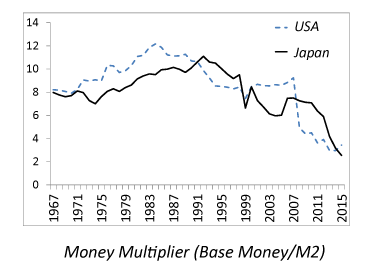
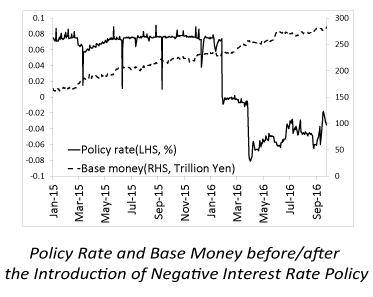 In particular, the monetary policy outlined in standard economics textbooks is inconsistent with the actual management of monetary policy. For example, monetary policy as expressed by the LM curve basically revolves around money supply policy: “base money is supplied to the short-term money markets → money stock is increased in money markets → policy rates are lowered through demand for money.” However, the money multiplier expressing the relationship between base money and money stock has been unstable since the 1990s, implying that it is difficult for central banks to directly control money stock. Moreover, in recent years, policy rate setting has actually been conducted in a manner almost entirely independent of base money supply. These observable facts suggest the role of monetary policy in the actual money markets differs entirely from standard textbook explanations.
In particular, the monetary policy outlined in standard economics textbooks is inconsistent with the actual management of monetary policy. For example, monetary policy as expressed by the LM curve basically revolves around money supply policy: “base money is supplied to the short-term money markets → money stock is increased in money markets → policy rates are lowered through demand for money.” However, the money multiplier expressing the relationship between base money and money stock has been unstable since the 1990s, implying that it is difficult for central banks to directly control money stock. Moreover, in recent years, policy rate setting has actually been conducted in a manner almost entirely independent of base money supply. These observable facts suggest the role of monetary policy in the actual money markets differs entirely from standard textbook explanations.
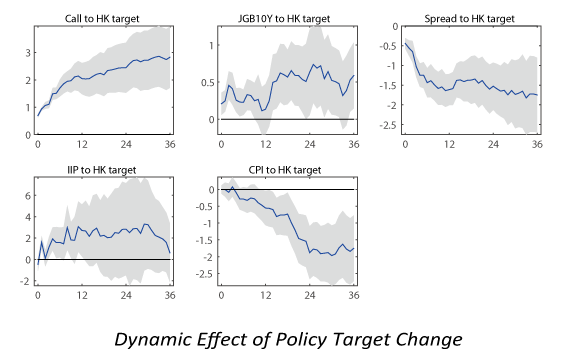
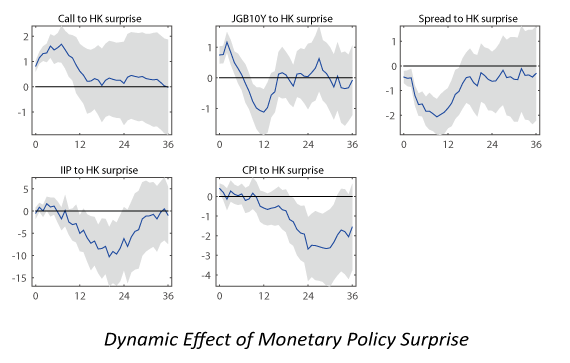 Also, monetary policy implied by the LM curve focuses exclusively on money supply policy in the role of stabilizing money markets, while actual monetary policy management extends to the broader financial markets including short-term policy rates in order to play a role in stabilizing the macroeconomy in relation to the real output and inflation. Shibamoto (2016a) shows empirically that policy effects are underestimated by ignoring the role of monetary policy as policy rate reacting endogenously to the economy and prices. The AS-IS-MP model using the monetary policy reaction function (MP), which depicts central banks setting policy rate in relation to economic conditions and the inflation rate, is one key tool of monetary policy analysis both in Japan and overseas used in place of the AS-IS-LM model.
Also, monetary policy implied by the LM curve focuses exclusively on money supply policy in the role of stabilizing money markets, while actual monetary policy management extends to the broader financial markets including short-term policy rates in order to play a role in stabilizing the macroeconomy in relation to the real output and inflation. Shibamoto (2016a) shows empirically that policy effects are underestimated by ignoring the role of monetary policy as policy rate reacting endogenously to the economy and prices. The AS-IS-MP model using the monetary policy reaction function (MP), which depicts central banks setting policy rate in relation to economic conditions and the inflation rate, is one key tool of monetary policy analysis both in Japan and overseas used in place of the AS-IS-LM model.
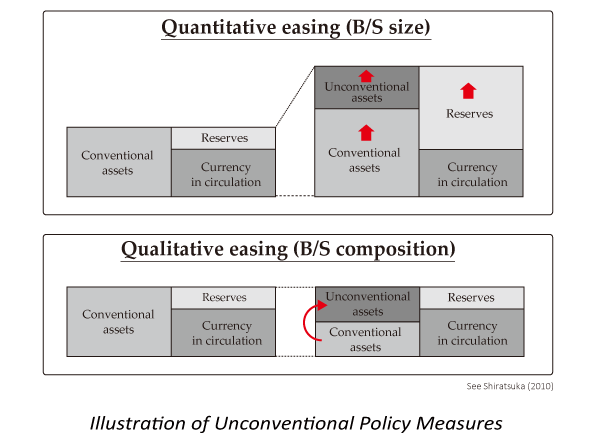
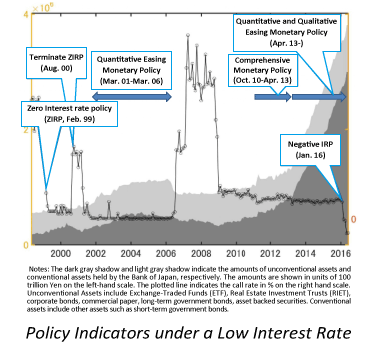
In recent years, however, central banks have not limited their policy tools to setting policy rate as assumed under the AS-IS-MP model. They have also conducted monetary policy through the utilization of unconventional policy tools such as supplying base money (quantitative easing) and purchasing non-traditional assets such as long-term government bonds, corporate bonds and equities (qualitative easing). Nakashima, Shibamoto and Takahashi (2017) developed econometric methods to separate and analyze the effects of policy rate setting, quantitative easing and qualitative easing and estimate their dynamic causal effects on financial markets and the real economy, showing that the transmission effects of monetary policy on the real economy through financial markets (equity prices and long-term yields) differ depending on the policy tools.
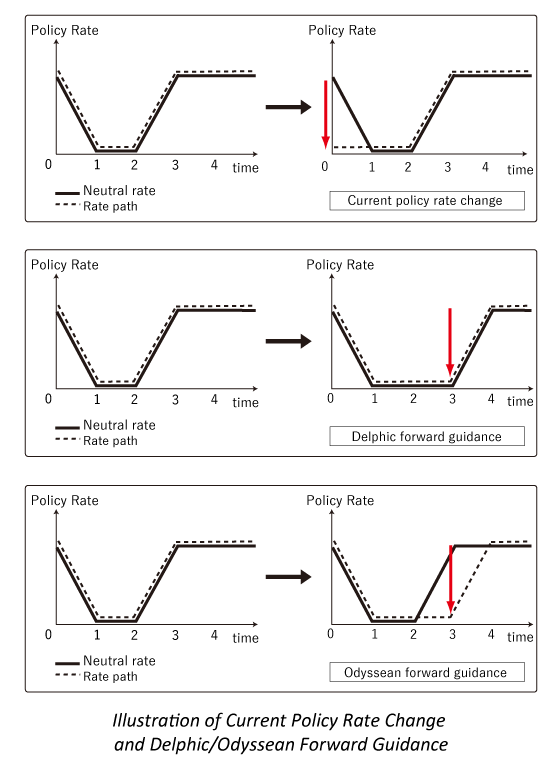
In recent years, there has been an emphasis not only on the role of policy tools but also on the importance of policy designed to act on expectations (expectations management policy). Shibamoto (2016b) shows through empirical analysis that communication with the markets has an effect separate from the effect of policy tools themselves, stressing the importance of such communication in accurately conveying a central bank’s intentions. Moreover, Shibamoto (2017) argues that forward guidance on future policy can have different policy effects depending on whether it takes the form of Delphic forward guidance (conveying future changes in policy conduct in accordance with changes in economic conditions) or Odyssean forward guidance (binding the future conduct of the policy authority itself).
Related research
- "Source of Underestimation of the Monetary Policy Effect: Re-examination of the Policy Effectiveness in Japan's 1990s" The Manchester School, Vol.84 Issue 6, 795-810, December 2016
- "Identifying Unconventional Monetary Policy Shocks" (joint with Kiyotaka Nakashima and Koji Takahashi), RIEB Discussion Paper Series No. DP2017-05, Kobe University, March 2017.
- "Empirical Assessment of the Impact of Monetary Policy Communication on the Financial Marke" RIEB Discussion Paper Series No.DP2016-19, Kobe University, April 2016
- "Market-Perceived Monetary Policy Surprises", 2017
2. Explaining the mechanisms of the business cycle in a period of secular stagnation
The economic mechanisms behind secular stagnation in Japan and other developed economies highlighted in recent years are examined empirically. In Japan during the Great Stagnation – the “lost 20 years” that followed the collapse of the bubble economy in the 1990s – and in developed economies after the global financial crisis, the continuing shortage of demand and drop in potential growth (natural rate of interest) have occurred simultaneously. This research project aims to show empirically the macroeconomic mechanisms behind secular stagnation by examining the realistic relevance of the premise in standard economic theory that the demand side does not affect the supply side over the long term (classical dichotomy) and by considering the possibility that demand and supply sides are correlated.
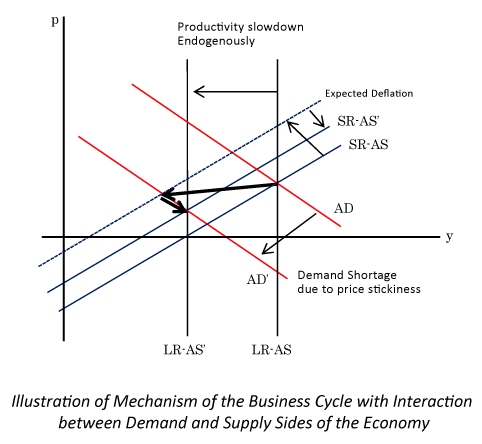 Although it is an essential first step to explain the mechanism of economic fluctuations based on aggregate demand and supply, actual data often does not statistically support the realistic relevance of the standard relationship between aggregate demand and supply. Shibamoto and Miyao (2012) argue that the realistic relevance of the hypothesis in standard economic theory that demand does not affect output over the long term (classical dichotomy) is not supported, and emphasize the importance of the correlation between the demand side and supply side in explaining the trend in output and prices during Japan’s period of secular stagnation from the 1990s. Shibamoto (2016c) shows that the realistic relevance of Euler’s equation based on the standard Constant Relative Risk Aversion-type asset price model (IS) cannot be recognized. Moreover, Shibamoto (2009) shows empirically that while the realistic relevance of the standard AS curve is limited, the ability of the AS curve to explain the inflation rate when consideration is given to the effect of monetary policy on the supply side is relatively sound.
Although it is an essential first step to explain the mechanism of economic fluctuations based on aggregate demand and supply, actual data often does not statistically support the realistic relevance of the standard relationship between aggregate demand and supply. Shibamoto and Miyao (2012) argue that the realistic relevance of the hypothesis in standard economic theory that demand does not affect output over the long term (classical dichotomy) is not supported, and emphasize the importance of the correlation between the demand side and supply side in explaining the trend in output and prices during Japan’s period of secular stagnation from the 1990s. Shibamoto (2016c) shows that the realistic relevance of Euler’s equation based on the standard Constant Relative Risk Aversion-type asset price model (IS) cannot be recognized. Moreover, Shibamoto (2009) shows empirically that while the realistic relevance of the standard AS curve is limited, the ability of the AS curve to explain the inflation rate when consideration is given to the effect of monetary policy on the supply side is relatively sound.
Related research
- "Interaction between Demand and Supply Sides of the Economy: The Case of Japan's Lost Decade" (joint with Ryuzo Miyao), 2012.
- "Re-investigating the Relevance of C-CAPM in Japan : Weak Identifcation Robust Inference Approach" Kokumin Keizai Zasshi, Vol. 214, No. 3, September 2016. (in Japanese)
- "The Estimation of the New Keynesian Phillips Curve in Japan and Its Implication for the Inflation Response to a Monetary Policy Shock" RIEB Discussion Paper Series No.235, Kobe University, January 2009.
3. Interdisciplinary arts and sciences research on the mechanism of expectations formation
The economic policies of Prime Minister Abe, or “Abenomics,” have been a focus in academic circles and the media around the world, not only in Japan. The Liberal Democratic Party (LDP) promised that with a change of administration it would promote a set of macroeconomic policies comprised of “three arrows” – bold monetary policy, flexible fiscal policy and growth strategy to spur private-sector investment – in a bid to end Japan’s prolonged economic slump (“lost 20 years”) and deflation. Equity market participants quickly reacted to this news and Japanese share prices turned up from the second half of 2012 amid whispers about a change of administration. With the favorable turn in the financial markets, the real economy has continued to recover in the form of business conditions and prices.
In the field of economics, financial and economic variables represented by equity prices are thought to depend on expectations about the future. As evident from the above facts, even if economic policies are not actually implemented, equity prices can change sharply in response to news related to policy about the future, then pass through to the real economy. The causal relationships of economic phenomena that are actually occurring cannot be understood if the role of future expectations is ignored.
However, in traditional economic forecasting models, the role of expectations is not adequately considered. The changes in market sentiment described above cannot actually be grasped sufficiently solely through quantitative data such as traditional macroeconomic variables. This means that the economic forecasting models primarily used by policy authorities and private research institutes (e.g, time-series models, structural models utilizing economic theory) are unable to capture actual economic phenomena via expectations such as those described above. It is therefore necessary to develop economic models based on new methods different from those used in the past.
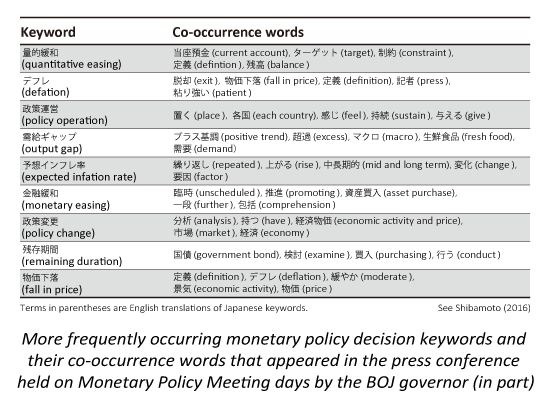
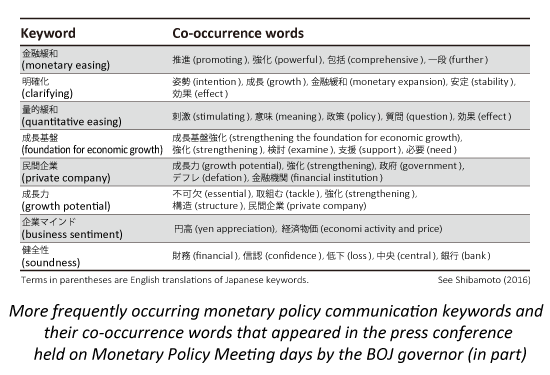 In recent years, deep-learning techniques modeling the recognition mechanisms of the brain in the field of cognitive sciences research have been a focus in the areas of artificial intelligence and data engineering. Deep learning is actually known to exceed the performance of traditional models in terms of visual and audio recognition. Deep-learning applications have also spread to the expression and recognition of linguistic information, and it is expected that in the near future they will be able to recognize knowledge from linguistic information (e.g, what the BOJ governor said) by learning models based on large amounts of linguistic data from such sources as newspapers, news streams and websites. The development of economic models based on such methods might be described as a new experiment of mining large amounts of linguistic data to obtain information that cannot be obtained from traditional quantitative data.
In recent years, deep-learning techniques modeling the recognition mechanisms of the brain in the field of cognitive sciences research have been a focus in the areas of artificial intelligence and data engineering. Deep learning is actually known to exceed the performance of traditional models in terms of visual and audio recognition. Deep-learning applications have also spread to the expression and recognition of linguistic information, and it is expected that in the near future they will be able to recognize knowledge from linguistic information (e.g, what the BOJ governor said) by learning models based on large amounts of linguistic data from such sources as newspapers, news streams and websites. The development of economic models based on such methods might be described as a new experiment of mining large amounts of linguistic data to obtain information that cannot be obtained from traditional quantitative data.
This research attempts to use new econometric methods including deep-learning techniques to extract information on people’s expectations that cannot be obtained from quantitative data by extracting it from linguistic data. Research that applies text-mining methods to analyze effects on financial variables reflected in equity prices has been conducted before and its importance has been frequently cited. This research attempts to build upon past knowledge from economics to comprehensively analyze the role of expectations about the future in relation to, for example, effects on various macroeconomic variables, including goods prices.
Related research
- "Empirical Assessment of the Impact of Monetary Policy Communication on the Financial Marke" RIEB Discussion Paper Series No.DP2016-19, Kobe University, April 2016
- "Constructing Financial Sentiment Lexicons for Individual Stocks" (joint with Kazuhiro Seki), 2017.
- "Measuring Social Change Using Text Data: A Simple Distributional Approach " (joint with Takashi Kamihigashi and Kazuhiro Seki), RIEB Discussion Paper Series No.DPDP2017-16, Kobe University, May 2017
4. Macroeconomic time-series analysis related to the economy during the Edo era in Japan
under construction